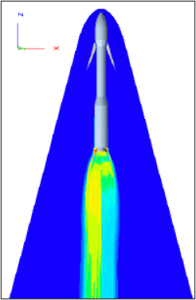Modelling of hot plume with particles for improved launcher applications
Programme
GSTP
Programme Reference
G614-011MP
Prime Contractor
CFS ENGINEERING SA
Start Date
End Date
Status
Closed
Country
Switzerland

Objectives
To provide with an improved model the for computation of plumes from solid rocket boosters, in order to reduce design margins for launch vehicles. The new model will permit the numerical simulation of hot gases with particles including chemistry, Lagrangian tracking for particles and radiation modelling for solids particles.
Description
The technical work will be organised in 2 phases. In Phase 1 a new model for hot plume with particles will be developed to include the necessary physics such that the combustion process can be computed, the evolution of the alumina can be calculated in the engine and the subsequent impact of the alumina in terms of heat radiation to the upper stages can be quantified. Finally, in Phase 2 the new model will be used in combination with any CFD code provided by the bidder and validated with experimental data provided by ESA.
Within Phase 1, a review of the simulation and modelling possibilities of the nozzle flow for solid propellant propulsion will be carried out. Existing chemistry packages will be evaluated and compared. The correct formulation of the models will be verified through the calculation of literature test cases. Also an strategy for the Lagrangian particle tracking model will be proposed and tested using simple validation cases from literature. The proposed strategy will be as complete as possible, and will indicate the level of modelling of the particles that will be implemented. Questions to be addressed in the proposal concern (among others) the agglomeration of particles, particle sizes, the evaporation of particles and the interaction of the particles with the mean flow. Further, since radiation contributes significantly to the overall heating of a launcher base region, two mechanisms will be modelled by considered: (1)heating of the base structure by hot plumes, especially for solid plumes, where hot AlO3 particles (contributing to roughly 16% of the plume mass flow) have to be considered as distributed radiation source in the plume. Simulation of this heat source would require to model the particle distribution in the plume and to apply a radiation model for this distributed heat source; (2)heat exchange between the plume and the launcher base, where also partial absorption of radiated heat in the ambient flow and in the plume should be taken into account. Finally, a review of radiation models for solid particles will be prepared, and a strategy will be proposed to allow a quantitative analysis of the above mentioned two most important radiation effects during launch and atmospheric flight.
Application Domain
Space Transportation
Technology Domain
18 - Fluid Dynamics
Competence Domain
7-Propulsion, Space Transportation and Re-entry Vehicles
Initial TRL
TRL 3
Target TRL
TRL 5
Achieved TRL
TRL 5
Public Document
Executive Summary
